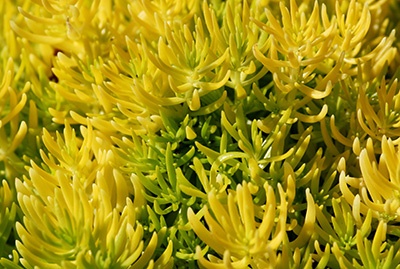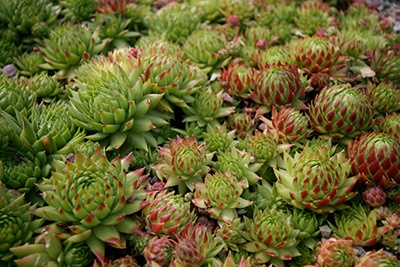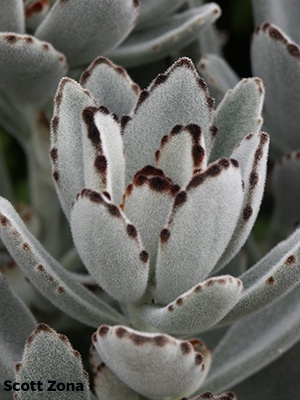Succulents

Succulents are a group of plants with fleshy stems and leaves that are efficient for storing water. They are generally found in arid or semi-arid climates and other harsh environments. While we don’t have a truly dry season in Florida, these unique, low-maintenance plants can still have a place in your landscape.
Because succulents are adapted to survive in dry conditions, they don’t need much supplemental water. In Florida’s rainy, humid climate, a good way to grow succulents is in containers, where irrigation and soil are easier to control.
Start with a shallow clay or terra cotta container with drainage holes; a coarse, well-drained sand mix is recommended. Let the soil dry out in between waterings and make sure your containers aren’t holding water; soggy soil will cause problems like root rot.
These planting conditions mean that succulents can be grown in some creative and attention-grabbing places, like rock gardens or even tucked into sandy pockets in stone walls. Using unique containers can be a lot of fun. Mix different forms, colors, and textures of succulents into one planter.
This is a varied group of plants, with members in over 60 plant families and thousands of hybrid cultivars. Common names can get confusing. “Hen and chicks” is one name that is used for a number of different succulents. The moniker comes from the propagating nature of these plants; the “hen” is the main plant, while the “chicks” are plantlets that form from the main plant. Some people are referring to Sempervivum when they say hen and chicks, while others mean Echeveria, or Sedum, or other forms of succulents. As always the Latin names provide the most clarity.
Some of the most popular succulents groups for growing in containers and in the landscape are Echeveria, Sedum, Sempervivum, and Kalanchoe.
Echeveria
Echeveria is a large group of succulents that have lovely foliage arranged in a rosette shape. These plants can be grown in containers outside throughout Florida. For the most part these plants will stay small, reaching only a couple inches across. Be sure you don’t let water sit in the rosette’s center as this can cause rotting or disease. You also may want to remove dead leaves from the bottom of your plant as it grows to help it stay healthy and attractive.
There are many Echeveria to choose from, but here are a few that you could feature in your home or garden. ‘Black Prince’ has striking dark red, almost black, leaves; these plants are shaped much like a water lily flower. ‘Ruffles’ has ruffled leaves that are tipped with red along the leaf edge. For the more traditional succulent look, try blue rose Echevaria (Echeveria imbricate), which is a native of Mexico that features blue-green leaves with hints of pink. As the name suggests, they resemble rose blossoms. For something different, Echeveria runyonii ‘Topsy Turvy’ has thick grey leaves that curl up and inwards.
Sedums

Sedums also have leaves arranged in a rosette shape, but they have their own unique look. They come in a variety of heights, ranging from just a few inches to 3 feet tall. Sedums can also have a trailing form, which makes them great for growing in containers that allow them to spill gracefully over the edge.
A broadleaf stonecrop (Sedum spathulifolium) variety called ‘Cape Blanco’ has striking silver leaves that look like blooming flowers. Sedum spurium ‘Tricolor’ has green leaves edged in white, while S. spurium ‘Dragon’s Blood’ enchants with cascading red foliage. Sedum repestre ‘Angelina’ has bright chartreuse foliage that definitely stands out—it looks more like something you might find growing in a coral reef. Sedum morganianum ‘Donkey Tail’ has trailing stems surrounded by smooth, lance-shaped overlapping leaves, resembling an animal’s tail. And a creeping sedum cultivar called Lemon Coral™ is a beautiful groundcover or accent plant to grow in a perennial garden or rock garden with full sun.
Sempervivum

Native to Europe and exceptionally cold hardy, Sempervivum succulents are often called houseleeks. They were were (and in some places still are) traditionally grown on the rooftops of homes in England and Wales for magical protection from lightning.
These succulents also have a beautiful tight rosette form and there are hundreds of species in the Sempervivum genus to choose from.
‘Royal Ruby’ gives you ruby-red to dark-red rosettes of leaves that resemble water lilies. If you’re looking for something on the green side, try the elegant ‘Green Wheel’ with pointed leaves.
Can’t decide between red or green? Have both: ‘Red Rubin’ has burgundy-tinged leaves encircled by green leaves and Sempervivum grandiflora has green leaves tipped with red. But for a true visual contrast, consider Sempervivum arachnaoideum, which has a cobweb-like mass of fine hairs that grow in the middle of a rosette of green leaves.
Kalanchoe

For something a bit different, consider kalanchoe, which has more of an upright or paddle-shaped form, depending on the species. Kalanchoe tomentosa Panda is an interesting—some might even say adorable—succulent. With its fuzzy white leaves that are spotted with brown along the margin, it’s not hard to visualize why this is called “panda bear plant” by some. Kalanchoe thyrsiflora, also called desert rose paddle plant, has chalky blue-green leaves that transition to red tips.
Succulents of all kinds have long been favorites in the garden. But their striking looks and low-maintenance lifestyle now have succulents booming in popularity as an element in interior design. You can regularly see them displayed in architectural magazines and as props in furniture galleries. From hotels to homes, succulents bring the outside in an eye-catching way.
With succulents being so easy to care for and uniquely beautiful, gardeners (especially beginning or busy ones) can’t go wrong.
